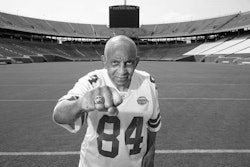Perhaps because keeping score is an intrinsic part of competitive sports, the NCAA has tracked diversity by the numbers, counting how many minorities and women work as coaches and athletic directors, particularly at schools in big-time Division I.
With the organization taking that singular approach, member colleges and universities overall have moved the ball on diversity more by inches than entire playing fields. In Division I, 7 percent of athletic directors are Black and about 10 percent are women. On men’s basketball teams, 61 percent of players are Black, while 23 percent of head coaches are.
Two years ago, new president Dr. Mark Emmert came up with another play for the NCAA’s offense on diversity. Besides collecting statistics, the national office in Indianapolis would promote change in campus culture as a way to increase the diversity of athletic directors, coaches and players.
“If we can change the culture, then we think that the numbers, the increase in representation, will be a direct by-product of a more inclusive culture,” explains Dr. Bernard Franklin, the NCAA’s executive vice president of membership and student-athlete affairs, who has taken on the additional role of chief inclusion officer.
Franklin, a former president of Virginia Union University, oversees a new Office of Inclusion that has broadened and consolidated the NCAA’s diversity efforts. The combined office brings together staff focused either on minorities or women, operations that were previously separate. Beyond race and gender, the expanded mission encompasses the LGBT community and athletes who are disabled, as well as international students.
“We are now probably functioning more as a choir than as soloists,” Franklin says.
So far, the new office has been laying the foundation for changing campus culture, by taking suggestions from member schools about what they need from the NCAA and about best practices they have in place already. A diversity summit last September attracted more than 175 people to Indianapolis and another 200 to the webcast.
Franklin has been meeting with college presidents and chancellors, who have a say in hiring athletic directors, coaches and athletic conference commissioners. Those top leaders also play a big role in shaping the culture and climate on campuses.
“We are looking at strategies to more effectively engage chancellors and presidents,” Franklin says. “Without them, we are not going to see a change in the landscape that we all desire to see.”
Floyd Keith, executive director of Black Coaches and Administrators, and a leading critic of hiring patterns at NCAA schools, sees how the new diversity thrust can work — alongside the old one.
“I think it’s noble. If you change the climate, you are eventually going to change the landscape, because people adjust to climate,” Keith says. “But a lot of times it’s hard to measure climate because you have to have something tangible to look at. So I don’t think you can ever get away from numbers.”
The NCAA’s bringing additional groups into the mix became necessary because diversity’s meaning has expanded, Keith says: “I think the approach is in concert with the times.”
A New Paradigm
The NCAA’s old approach on numbers and new one on culture will come together this summer, when the Office of Inclusion holds a roundtable discussion of recruiters from search firms that identify candidates for athletic jobs.
Kimberly Ford, NCAA’s director of minority inclusion, says the discussion at a convention of the National Association of Collegiate Directors of Athletics this month in Dallas will examine issues related to hiring minorities and women and “how the NCAA can play a more critical role in that particular process.”
At its own convention next year, the NCAA is collaborating with the Minority Opportunities Athletic Association to present the first diversity award to a member school. From the pile of nominations, the Office of Inclusion will cull descriptions of promising practices.
“We’re going to compile a list of that information into a best practices document for the membership to use as an additional resource,” Ford says.
Franklin has already identified one best practice. It comes from Division III, whose schools do not award athletic scholarships. The North Coast Athletic Conference in the Midwest has a pilot program that he says identifies and mentors “minority student athletes who have an interest in intercollegiate athletics as a profession.” The NCAA will probably support that program, Franklin adds.
Karen Morrison, NCAA’s director of gender inclusion, describes as another best practice the NCAA’s “improved transgender student-athlete policy” designed to “protect student-athletes” and “the integrity of women’s sports and its competitive attributes.”
Other policy changes that would affect all Division I schools have been the subject of preliminary discussions between the Office of Inclusion and the National Association of Diversity Officers in Higher Education. The NCAA has been reviewing the certification process that those schools undergo every 10 years to ensure their athletics programs comply with Division I guidelines.
Dr. Benjamin D. Reese Jr., president of the National Association of Diversity Officers in Higher Education, says NCAA representatives approached the organization about “helping them think through, perhaps, a new form and process in rating diversity and inclusion” as part of the certification process.
Reese, who is vice president for institutional equity at Duke University, says the effort now in the planning stage is likely to consider demographics, culture and climate, and “student-athletes’ experience on the campus,” including academics. Closing disparities in the graduation rates of Black athletes, Franklin says, is not explicitly a part of the Office of Inclusion’s mandate, but a responsibility that the NCAA’s entire national office shares.
The Office of Inclusion, Franklin says, did have input into a NCAA policy announced in late April that gives HBCUs and schools with limited financial resources an additional year, until 2016-2017, to reach a 50 percent graduation rate for athletes. The policy recognizes that such schools admit underprepared students who otherwise might not go to college.
Going Beyond the Numbers
The NCAA’s new emphasis on campus climate and culture is in keeping with the increased attention that college diversity staffers have been paying to those issues. By adding that thrust to its diversity efforts, the NCAA is essentially conceding its numbers-driven approach has gone only so far in changing hiring practices in athletic departments.
Asked about the effectiveness of the previous approach, Keith refers to the outcomes at Division I schools: “In athletic administration and men’s basketball, the change has been minimal or, even in some areas, it’s gone down.”
Keith does note recent improvement in hiring Black coaches in the Football Bowl Subdivision has increased their representation.
“Even though it isn’t where it should be, we don’t flinch anymore when a guy is announced as being the head coach,” he says.
While he sees the potential benefits of changes in campus culture, Keith argues that stronger accountability mechanisms are needed, such as the equivalent of the NFL’s Rooney Rule, which requires minorities to be included in the pool of candidates for head coaching vacancies. In 2009, Oregon adopted a similar state law covering coaching and athletic director vacancies at state universities.
As a nonprofit association of voluntary members, the NCAA says under the law it cannot adopt a rule similar to one imposed by the NFL, a for-profit business. But four years ago, athletic directors in Division I adopted voluntary guidelines comparable to the Rooney Rule.
Another of Keith’s suggestions has gotten no traction in Congress: Federal legislation on minority participation in college athletics parallel to Title IX for women. Keith thinks such a law would hold colleges accountable to the government.
Unlike Keith, Reese does think ways could be devised to measure campus climate. The clinical psychologist by training suggests athletic departments, to optimize diversity, need to be more like well-functioning families that strive to improve relationships continually.
“If you think of creating a respectful and healthy environment within a family, it’s not that you reach a certain point within a family,” Reese says. “But heads of families often talk about how we can create the kind of healthy, respectful environment that helps everyone feel fully engaged and enjoy the life of a family.”


















